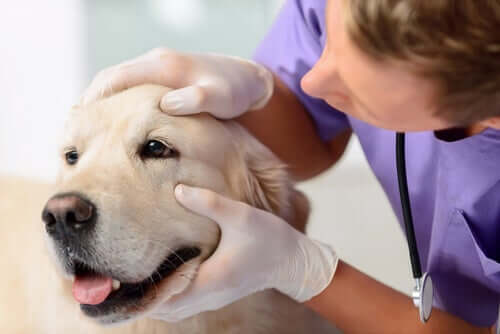Canine Eye Infection in Older Dogs

The eyes are an important, but sensitive, organ that can be damaged in different ways. However, an eye infection is just one of the different diseases that can affect the eyes. Therefore, depending on the type of canine eye infection, treatment will vary.
What’s an eye infection?
An eye infection is the result of the presence of bacteria, which multiply in the area of the infection. The most common ones are bacteria, viruses or fungi. In addition, infections can occur in different parts of the eye and affect one or both eyes.
Among the most common eye infections are Conjunctivitis (or dry eye) and Keratoconjunctivitis. Lack of moisture in the cornea is the cause of the latter. However, dogs may also suffer other eye problems such as cataracts or glaucoma, for instance.
What factors lead to an eye infection in adult dogs?
In adult dogs, their age is one of the different factors that can influence eye infections. Both puppies and adult or senior dogs can suffer eye infections all the same.
The eyes are an essential yet considerably delicate organ. Cleaning them is an important part of eye care. Therefore, we recommend following a series of recommendations to avoid any infections as much as possible:
- Clean the dog’s eyes on a regular basis. It’s possible to find different products in stores that specialize in eye care. However, an affordable option is the use of physiological serum, which allows the removal of possible dirt in the eye.
- Remove hair from the eyes. It’s advisable to trim or remove all hair that hinders vision or that may cause problems in the future.
- Eyelash care. Sometimes your dog’s eyelashes can be excessively long, so we suggest trimming them if the animal isn’t comfortable.

Another factor to consider is the area where the infection occurs. Infections can be located in different regions of the eye:
- The eyelids. Different infections can be found in this area, such as Blepharitis or Distichiasis.
- The conjunctive membrane. In this section of the eye, it’s possible to find Conjunctivitis or Keratoconjunctivitis infections.
- The cornea
Treatments available for eye infections in older dogs
As mentioned above, the main culprits in eye infections are pathogens such as bacteria, viruses, fungi or parasites. Depending on the cause and type of infection, treatment will vary accordingly. Below, we’ll discuss two specific pathologies with their respective symptoms and treatments.
Conjunctivitis
Conjunctivitis is a condition that causes inflammation of the conjunctive membrane in the eye. This transparent membrane covers the eyelids on one part and the sclera of the eye on the other.
The most striking symptoms are inflammation, which causes redness and secretion. The causes of canine conjunctivitis are pathogens, foreign agents or bacteria. Depending on the type of secretion, the diagnosis will be different.
First and foremost, treatment will depend on the cause. However, treatment will always include cleansing the eye with a saline solution and removing any foreign body or substance.
Canine Ehrlichiosis
This infectious disease is usually caused by a member of the Rickettsias bacterial family (Ehrlichia Canis, specifically). This disease is a serious one and has been found in different continents of the world, such as Africa, America, Asia, and Europe.
This bacteria affects not only dogs but also humans, cats, and other large animals. In addition, some characteristic mild symptoms of Canine Ehrlichiosis are appetite loss, heavy breathing, fever, or swollen glands.
If the disease isn’t diagnosed by a vet, the worsening of symptoms can range from impaired senses to a loss of coordination and even consciousness. In addition, an early diagnosis is necessary to achieve complete recovery.
The treatment requires the administration of antibiotics for a certain period of time, usually about four weeks. Moreover, blood transfusions may sometimes be required if the dog shows signs of anemia.
However, if the dog’s meninges are affected, the disease can be fatal even with treatment. Therefore, the best treatment, in this case, is prevention.

While we have mentioned various infections and their treatments, always seek professional advice if you observe any symptoms or alarming behavior in your dog. The vet will always be the best advisor in these cases.
We hope you found this article useful and we wish the best of health for your dear pets and for you. Remember, prevention is the best treatment!
The eyes are an important, but sensitive, organ that can be damaged in different ways. However, an eye infection is just one of the different diseases that can affect the eyes. Therefore, depending on the type of canine eye infection, treatment will vary.
What’s an eye infection?
An eye infection is the result of the presence of bacteria, which multiply in the area of the infection. The most common ones are bacteria, viruses or fungi. In addition, infections can occur in different parts of the eye and affect one or both eyes.
Among the most common eye infections are Conjunctivitis (or dry eye) and Keratoconjunctivitis. Lack of moisture in the cornea is the cause of the latter. However, dogs may also suffer other eye problems such as cataracts or glaucoma, for instance.
What factors lead to an eye infection in adult dogs?
In adult dogs, their age is one of the different factors that can influence eye infections. Both puppies and adult or senior dogs can suffer eye infections all the same.
The eyes are an essential yet considerably delicate organ. Cleaning them is an important part of eye care. Therefore, we recommend following a series of recommendations to avoid any infections as much as possible:
- Clean the dog’s eyes on a regular basis. It’s possible to find different products in stores that specialize in eye care. However, an affordable option is the use of physiological serum, which allows the removal of possible dirt in the eye.
- Remove hair from the eyes. It’s advisable to trim or remove all hair that hinders vision or that may cause problems in the future.
- Eyelash care. Sometimes your dog’s eyelashes can be excessively long, so we suggest trimming them if the animal isn’t comfortable.

Another factor to consider is the area where the infection occurs. Infections can be located in different regions of the eye:
- The eyelids. Different infections can be found in this area, such as Blepharitis or Distichiasis.
- The conjunctive membrane. In this section of the eye, it’s possible to find Conjunctivitis or Keratoconjunctivitis infections.
- The cornea
Treatments available for eye infections in older dogs
As mentioned above, the main culprits in eye infections are pathogens such as bacteria, viruses, fungi or parasites. Depending on the cause and type of infection, treatment will vary accordingly. Below, we’ll discuss two specific pathologies with their respective symptoms and treatments.
Conjunctivitis
Conjunctivitis is a condition that causes inflammation of the conjunctive membrane in the eye. This transparent membrane covers the eyelids on one part and the sclera of the eye on the other.
The most striking symptoms are inflammation, which causes redness and secretion. The causes of canine conjunctivitis are pathogens, foreign agents or bacteria. Depending on the type of secretion, the diagnosis will be different.
First and foremost, treatment will depend on the cause. However, treatment will always include cleansing the eye with a saline solution and removing any foreign body or substance.
Canine Ehrlichiosis
This infectious disease is usually caused by a member of the Rickettsias bacterial family (Ehrlichia Canis, specifically). This disease is a serious one and has been found in different continents of the world, such as Africa, America, Asia, and Europe.
This bacteria affects not only dogs but also humans, cats, and other large animals. In addition, some characteristic mild symptoms of Canine Ehrlichiosis are appetite loss, heavy breathing, fever, or swollen glands.
If the disease isn’t diagnosed by a vet, the worsening of symptoms can range from impaired senses to a loss of coordination and even consciousness. In addition, an early diagnosis is necessary to achieve complete recovery.
The treatment requires the administration of antibiotics for a certain period of time, usually about four weeks. Moreover, blood transfusions may sometimes be required if the dog shows signs of anemia.
However, if the dog’s meninges are affected, the disease can be fatal even with treatment. Therefore, the best treatment, in this case, is prevention.

While we have mentioned various infections and their treatments, always seek professional advice if you observe any symptoms or alarming behavior in your dog. The vet will always be the best advisor in these cases.
We hope you found this article useful and we wish the best of health for your dear pets and for you. Remember, prevention is the best treatment!
All cited sources were thoroughly reviewed by our team to ensure their quality, reliability, currency, and validity. The bibliography of this article was considered reliable and of academic or scientific accuracy.
-
Conjuntivitis en perros. Evaluación virológica | Vets & Clinics [Internet]. [citado 11 de noviembre de 2019]. Disponible en: https://www.affinity-petcare.com/vetsandclinics/es/conjuntivitis-en-perros-evaluacion-virologica
-
Enfermedades oculares del perro senior | Purina® PRO PLAN® Perro [Internet]. [citado 11 de noviembre de 2019]. Disponible en: https://www.purina.es/proplan/consejos/enfermedades-oculares-perro-senior.html
-
Infecciones de los ojos: MedlinePlus en español [Internet]. [citado 11 de noviembre de 2019]. Disponible en: https://medlineplus.gov/spanish/eyeinfections.html
This text is provided for informational purposes only and does not replace consultation with a professional. If in doubt, consult your specialist.








